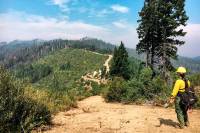Four Fantastic Climbing Areas to Check Out in Honor of National Forest Week
From the steep gorges of the southeast to the aptly named Rocky Mountains, public lands in the U.S. are replete with rock climbing opportunities. During this year’s National Forest Week, we are highlighting a selection of our favorite crags located on National Forest land.
While distinct signage and traffic jams clearly define the boundaries of National Parks like Yosemite and Zion, National Forests have subtle and understated borders. It is likely that many climbers who frequent the crags on this list do so without realizing that they have entered forest land.
And as luck would have it, this week (July 12-18) is National Forest Week, hosted by the National Forest Foundation (NFF). A congressionally chartered organization working to inspire meaningful connections between people and National Forests, the NFF hosts virtual events, learning initiatives, giveaways, and more during this celebratory week.
“During National Forest Week, our goal is to get the word out,” Mary Mitsos, NFF president and CEO told us. “By engaging the community, we can invite more people to enjoy and steward these lands.”
To help celebrate this week and the fun that national forests offer, we’ve pulled together our short list of great climbing areas within these public lands.
Red River Gorge, Daniel Boone National Forest

In the very same way that surfers revere the perfect waves of Oahu’s North Shore, rock climbers around the world treasure the sandstone walls of the Red River Gorge. While some are skeptical that Kentucky could be home to world-class climbing, a visit to the Red will erase any doubt.
Located within the traditional lands of the Cherokee and Shawnee people, the Red River Gorge is a designated National Natural Landmark currently managed as part of the Daniel Boone National Forest.
Though a sprinkling of classic trad lines can be found throughout the gorge, the Red is most commonly associated with overhanging bolted sport climbs. Standout crags such as the Dark Side and the Motherlode are the real-life manifestations of a sport climber’s grandest dreams. Endless chalk-covered paths of in-cut finger buckets soar into the sky.
Thanks to 400 million years of geological history and a unique combination of cementation and chemical weathering, the holds at the Red are comfortable to grab, and they feature a soft and sticky texture reminiscent of 100 grit sandpaper.
For the most part, the routes are well-protected and the falls are clean. The Red is a sport climber’s divine abode — bliss radiates from the faces of stoked crag goers.
Spring and fall are the best seasons to visit the Red, though periods of wet and stormy weather can come along at any time. Miguel’s Pizza is a staple food and camping hub that is essentially the nucleus of Red River Gorge climbing culture.
All climbers should be aware that there are numerous land management designations in the area in addition to national forest land. Certain areas are privately owned and managed.
Before hitting the crag, always look into specific rules, regulations, and ethics that may apply. Local climbing organization Red River Gorge Climber’s Coalition is an excellent up-to-date resource.
American Fork Canyon, Uinta National Forest

American Fork Canyon is located less than one hour south of Salt Lake City on the Uinta National Forest. Hundreds of pocket-laden routes on slick and technical limestone make American Fork a fantastic venue to hone your climbing skills.
In the late 1980s, bolt-protected sport climbing was a brand-new concept — a twinkle in the eye of a few visionary and resourceful climbers dispersed across the world. During the first wave of the sport climbing revolution, American Fork quickly became one of the first fully bolted crags in America.
During these early years of climbing in the canyon, the world’s most talented climbers frequently traveled to the U.S. to test themselves against the demanding routes, which were among the hardest in the world at the time. From the creative hotbed of American Fork, sport climbing spread rapidly throughout the United States and beyond.
Today, there are about 500 established routes in American Fork. The steep canyon walls generate ample shade, and good climbing conditions can be found almost every month of the year. Classics exist at every grade, though a large portion of climbs are 5.11 and up.
Just about every route features at least one of American Fork’s distinctive oblong football-shaped pockets. A technique tip from the locals: When in doubt, try a hand jam in a pocket. Trad climbing skills can be the key to sending at this iconic bolt-clipping wonderland.
In addition to stellar rock climbing, the Uinta National Forest is also home to Mt. Nebo, the highest peak in the Wasatch Range. The forest’s name is derived from the Ute word Yoov-we-teuh, which means pine tree or pine forest.
Taquitz Rock, San Bernardino National Forest

One of the cornerstones of climbing is that new generations can return to the test piece routes of bygone eras. Taquitz Rock, a large granite outcropping on the San Bernardino National Forest in California, is a living, interactive museum of climbing history.
As the birthplace of the now-universal Yosemite Decimal System, Taquitz has served as a proving ground and source of productive inspiration for nearly a century of recorded history. Today, modern climbers can go to Taquitz to experience the very first 5.9 in the United States, and imagine how it felt to be at the cutting edge of free climbing in 1952.
Most of the climbing on Taquitz follows elegant crack systems to the summit of the pyramid-shaped formation. Though some single pitch routes exist, the most popular climbs are at least three pitches in length.
All climbers visiting Taquitz should be aware that it is a traditional crag and much of the climbing is bold and serious in nature, and route-finding on the steep approach and descent can be difficult.
Though there are numerous grand lines to climb on Taquitz, some of the heavy-hitter classics are Fingertip, Open Book, and The Vampire. These highly regarded routes are popular on the weekends, so it is wise to be flexible. Be sure to come to the crag with a plan B in mind.
The San Bernardino National Forest is the traditional land of the Cahuilla and Soboba peoples. Just beyond the summit of Taquitz Rock is the true summit of Taquitz Peak at 8,846 feet. Other top-notch climbing opportunities nearby include Suicide Rock and an immense volume of magnificent granite bouldering.
Looking Glass Rock, Pisgah National Forest

Nestled within Pisgah National Forest, Looking Glass Rock is a 500-foot-tall granite dome surrounded by dense stands of old-growth trees. The climbing style at Looking Glass is as vintage and time-worn as the neighboring pines and hemlocks. This is due in part to its traditional crag features like tricky gear placements and heady slab routes.
The fall and winter months offer the best conditions for climbing at Looking Glass. However, various aspects and microclimates allow for comfortable cragging all year round.
On the steep and intimidating North Side, difficult free climbs and Yosemite-esque aid routes remained shaded throughout the day in the summertime. The south side of the mountain is more beginner-friendly, with ample routes in the 5.7-5.10 range.
For climbers with a resume steeped in overhanging sport routes and powerful boulders, Looking Glass will surely provide a fresh challenge. This crag exemplifies the fine art of slab climbing, and for those untrained in this discipline, 5.10 can easily feel like 5.12. This is especially true in the humid North Carolina air.
Also, many footholds and handholds are little more than barely detectable undulations in the granite. Horizontal sloping pockets known to locals as “eyebrows” make up the majority of the finicky gear placements. Don’t forget your rack of Tricams!
One of the oldest National Forests east of the Mississippi, Pisgah is inextricably linked to the history of American forestry. Located in the southern part of the forest, the Biltmore Forest School was the first school of forestry in the United States.
Management practices developed here played an important role in the birth and growth of the U.S Forest Service. Modern-day Pisgah exists on the traditional territory of the Cherokee and S’atsoyaha people.
National Forest Week: Explore It All
The theme of this year’s National Forest Week is “Explore it all.” Seven out of 10 Americans live within 2 hours of a national forest. However, in-person access to forest land is not straightforward for everyone.
“For many people, visiting a national forest is logistically challenging,” Mitsos said. “Though we always encourage people to get out and spend time in their local green space, we also want to provide educational resources about national forests and grasslands that are easy to access, even when actual places are not.”
Over the course of National Forest Week, the NFF will be hosting virtual events including a photo contest, live discussions, and a forest-themed draw-along with artist Bryn Merrell.
The post Four Fantastic Climbing Areas to Check Out in Honor of National Forest Week appeared first on GearJunkie.


